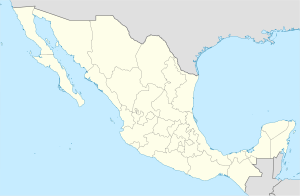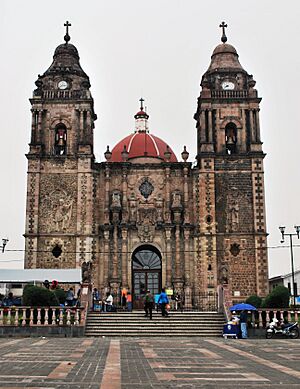Santiago Tianguistenco facts for kids
Quick facts for kids
Santiago Tianguistenco
|
|
|---|---|
|
City
|
|

Municipal Palace of Santiago Tianguistenco
|
|
| Country | |
| State | State of Mexico |
| Municipality | Tianguistenco |
| Founded | 1500s |
| Area | |
| • City | 121.53 km2 (46.92 sq mi) |
| Elevation
(of seat)
|
2,620 m (8,600 ft) |
| Population
(2005) Municipality
|
|
| • City | 64,365 |
| • Seat | 19,033 |
| Time zone | UTC-6 (Central (US Central)) |
| • Summer (DST) | UTC-5 (Central) |
| Postal code (of seat) |
52600
|
Santiago Tianguistenco is a city in Mexico State, about 30 km south of Toluca. Locals often call it Santiago. It is the main town for the Tianguistenco municipality. The city is in the southwest of the Toluca Valley, near the Ajusco mountains. These mountains separate it from Mexico City.
The name Tianguistenco comes from Nahuatl. It means "at the edge of the tianguis". A tianguis is a traditional Aztec market. Santiago was added to the name later, from its early Spanish name "Villa de Santiago." This area was once famous for having one of the best markets in the Toluca Valley. Today, it still has a large permanent market and a weekly tianguis that takes over the historic center.
Besides its markets, the municipality has a big factory that makes commercial trucks. It also has a community called Gualupita, known for its wool products. Santiago Tilapa is famous for a special festival. The Atenco Hacienda is where bullfighting in Mexico first started.
A Look at History
Early Settlements
We haven't found very old artifacts in this exact area. But in nearby Almoloya del Río, tools from the Olmec era show people lived here as early as 1300 BCE. There is also proof of the Teotihuacan culture's influence. Most ancient finds are near a former lake and Tetépetl Mountain.
In Tianguistenco itself, a town called Teotenanco existed between 1050 and 1260 CE. Its buildings look like those from Teotihuacan. The center had a special area for ceremonies. The first known people here were the Matlatzincas. In the 1470s, Axayacatl conquered this area, making it part of the Aztec Empire.
Colonial Times
After the Aztec Empire fell in 1521, Spanish leaders divided the land. Around 1523, Tianguistenco became part of a large land grant called an encomienda. This land was controlled by Leonel de Cervantes. It stayed in his family until 1617.
For much of the time under Spanish rule, this area depended on other towns like Metepec. Many local villages were run by a system called the Republica de Naturales. This system gave native people some control over their own communities. However, this system ended in 1778.
The most important place for the economy was the Purisima Concepcion Hacienda. Hernán Cortés himself started this large farm. It stayed with his family for a long time.
By the late 1700s, Tianguistenco grew bigger. It became important enough to have a customs house. It also became a center for mail service. The main church began construction in 1756.
Independence and Growth
During the Mexican War of Independence, Miguel Hidalgo y Costilla and his army passed through in 1810. Later, in 1812, freedom fighters were active in the nearby Ajusco Mountains. Most of the fighting here was small attacks by these groups.
The first local government was formed in 1820. Tianguistenco became its main town. This government supported Mexico's independence in 1821. In 1825, Tianguistenco became part of the State of Mexico. Over time, some communities that were part of Tianguistenco formed their own municipalities.
During the Reform War in 1857, the town and the Purisima Concepcion Hacienda were attacked. Many people here supported the Conservative side.
The municipal palace, where the local government works, was started in 1903. It was finished in 1910, just in time for Mexico's 100th anniversary of independence.
The Mexican Revolution and Modern Era
During the Mexican Revolution, the town first supported Francisco I. Madero. But when Emiliano Zapata started fighting again, Tianguistenco became a Zapatista town. Zapata's forces and the government army fought over the town many times.
In 1996, the state government officially declared Tianguistenco a city.
In the early 2000s, a new highway section opened. This helped with traffic between Santa Cruz Atizapan and Santiago Tianguistenco. It is part of a bigger highway project.
Exploring the City
The city of Santiago Tianguistenco has narrow streets. You can still see some old adobe houses with red tile roofs. The historic center has gardens, public buildings, and churches. These buildings show old architectural styles.
Santa María del Buen Suceso Church
The main church is called Santa María del Buen Suceso. It was built in the 1700s and faces the main plaza. The church has a very detailed "Ultra-Baroque" style. Its front has two parts and columns with three different decorations. The church was paid for by José de la Boda, a rich French miner. It looks similar to the Santa Prisca Church in Taxco. Its bell towers are like those of the Metropolitan Cathedral in Mexico City. This church is the most important historically. But there are over a dozen other old churches in town. Some date back to the 1500s and are protected as historical monuments.
Markets and Food
Next to the main church, facing the plaza, is the municipal palace. Across from the palace is the municipal market. Here you can find local dishes like moles, tamales, and barbacoa. During the rainy season, dishes made with wild mushrooms, fresh corn, and green fava beans are popular. People also make and drink fruit liquors. Special sweets include a paste made from tejocotes wrapped in corn husks, amaranth bars, and a brittle made with squash seeds.
Tuesday is market day. Stands set up on the city streets, creating a huge tianguis. This adds to the goods sold in the permanent market. The ancient market here was one of the richest in pre-Hispanic times. Today, this tianguis tradition is very well-preserved. About 3,500 merchants come for the day. The city is a regional trading hub. It is also a stop for people traveling to Chalma.
Gualupita: The Wool Capital
Guadalupe Yancuictlalpan is a community connected to the main city. It's known as Gualupita because of its church dedicated to the Virgin of Guadalupe. This community is famous for its wool items. These are the only traditional crafts still made in the municipality. Woven items are made on old wooden looms. Many of these looms have been in families for generations. People have been making textiles here since at least 1472. They first used fibers from the maguey plant. After the Spanish arrived, they mixed these fibers with wool.
Every weekend, hundreds of craftspeople come to Gualupita. They sell sweaters, vests, scarves, hats, and coats. Prices range from 20 pesos to 4,500 pesos. Items are made from wool, cotton, and some synthetic fibers. The most special pieces are made with undyed wool. The most expensive items are custom-made, with a fine coat costing up to 6,000 pesos. Designs often come from the Mazahua, Otomi, and Nahua groups.
Gualupita also holds an Atole Festival on May 2nd. On this day, people from Gualupita go to Ocuilán. They bring back 30 kilos of laurel branches, one by one, to the town church. When the first person arrives, the church bells ring. This yearly event has had as many as 1,500 participants.
Daimler Truck Plant
The biggest economic driver for the city is the Daimler Vehículos Comerciales Mexico plant. Locals simply call it "La Mercedes." This factory has been running since 1969. It is the only place where the Coronado tractor trailer is made. It started as a factory called Autocar. Later, Mercedes-Benz bought it in 1991. Since then, the factory has made over 272,000 vehicles. These trucks are mostly sent to other countries, like the United States, Canada, and Latin America.
The Municipality
The city of Santiago Tianguistenco is the main governing center for almost sixty other communities. The municipality covers 121.53 square kilometers. Less than a third of the municipality's people live in the main city. The municipality shares borders with many other municipalities. It also borders the Federal District to the east and the state of Morelos to the south.
Geography and Climate
The municipality is in the Trans-Mexican Volcanic Belt. About 35% of the land is mountainous, 30% is farmable, and the rest is developed. The eastern parts are highest, in the Ajusco mountains, over 3,600 meters above sea level. The rest of the municipality is flatter, part of the Lerma River plain, around 2,600 meters high. There are small volcanoes like Los Cuates and Santiago Tilapa.
The main river is the Lerma River, which flows through the municipality. There are also many small streams. Waterworks built in the 1940s supply water to Mexico City from this area. The climate is quite cold. Freezing temperatures happen about 100 days a year, from October to May.
Nature and Wildlife
Wild plants change with the height of the land. The mountains have forests of oak, pine, and fir trees. Lower areas have bushes and grasslands. Most animals here are small to medium-sized. You might see coyotes, skunks, rabbits, and squirrels. There are also reptiles like rattlesnakes and birds like crows, ducks, and quail. In the past, there were deer, buzzards, and wildcats, but they are gone now.
Economy and Agriculture
The Daimler Vehículos Comerciales Mexico plant is the biggest industry. It focuses on making trucks and related research. The factory has been open since 1969. It is the only place where the Coronado tractor trailer is made. It also produces Freightliner Trucks. These trucks are mainly for export to the United States, Canada, and Latin America.
Other industries include processing milk and meat. There are also factories in the Santiago Tianguistenco Industrial Park. Farming is still important. Farmers grow corn, carrots, oats, and fava beans. They also raise cattle, sheep, pigs, and chickens.
Special Places Outside the City
Sanctuary of Santiago Tilapa
One important place is the Sanctuary of Santiago Tilapa. Every August, this community celebrates its patron saint. This festival is well-known in the State of Mexico. A dance group called the Aventureros started in the mid-1900s. It was a dance tradition by muleteers and farmers, called the "Dance of the Muleteers." The dance has sixteen parts, like "The arrival" and "The sale." Dancers have different roles, each with its own costume and colors.
Atenco Hacienda
The Atenco Hacienda is not the biggest farm in Mexico, but it is the oldest. It is the oldest place on the continent to raise livestock. It still raises bulls, mostly for bullfights. A cousin of Hernán Cortés, Juan Gutiérrez Altamirano, founded the hacienda around 1528. It was very large, with about 30,000 hectares and 2,000 workers. It operated until the Mexican Revolution, when it was divided up. Now, the main house and other buildings are much smaller.
Fighting bulls were first brought to Mexico in the 1500s from Spain. Native people were afraid of these new animals. The main part of the hacienda is considered where Mexican bullfighting began. The corrals for the bulls and the chapel were built in 1550. The first official bullring in Mexico was built here in 1820. Famous bullfighters like Ponciano Diaz, Juan Belmonte, and Rodolfo Gaona came through here.
Notable People
- Salvador Sánchez, a famous boxer.
See also
 In Spanish: Santiago Tianguistenco para niños
In Spanish: Santiago Tianguistenco para niños



